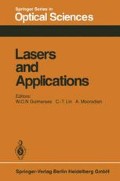Abstract
In 1921, Professor C.V. Raman started a series of experimental studies on the scattering of light in the Indian Association for the Cultivation of Science at Calcutta. Working over a period of seven years Raman and his students established the various laws of scattering of light. Continuing his researches in the same field he also discovered a new scattering phenomenon of a fundamental character now known as “Raman Effect”, in the early part of 1928. In this experiment it was found that when a beam of monochromatic light was incident on a medium, whether it be a gas, liquid or solid, part of the light was scattered in all directions with a change of frequency. Quantum mechanically the phenomenon is visualized as inelastic scattering of light in which an incident photon is absorbed and a scattered photon of higher or lower frequency compared to that of the absorbed one is emitted. The energies of the incident and scattered photons differed by an amount corresponding to the energy difference between the quantum-mechanical states or levels of the scattering medium. The fundamental and most important aspect of Raman scattering is that it provided an easily accessible tool for the spectroscopic investigation of energy levels of systems not usually accessible by the usual absorption and emission techniques. Depending on the range of energy levels and the agencies respomsible for this mechanism, the Raman scattering process could be classified under different connotations.
The late Professor Sergio Porto was one of the two pioneers who initiated research on laser Raman spectroscopy and had contributed substantially to its progress. It was therefore considered appropriate to present the results of this survey at the International Conference on Lasers and Applications arranged to commemorate Professor Sergio Porto. One of us (R.S.K) had the privilege of working with him for a short period.
Access this chapter
Tax calculation will be finalised at checkout
Purchases are for personal use only
Preview
Unable to display preview. Download preview PDF.
Author information
Authors and Affiliations
Editor information
Editors and Affiliations
Rights and permissions
Copyright information
© 1981 Springer-Verlag Berlin Heidelberg
About this paper
Cite this paper
Krishnan, R.S., Shankar, R.K. (1981). A Statistical Analysis of Trends in Research on Laser Raman Spectroscopy. In: Guimaraes, W.O.N., Lin, CT., Mooradian, A. (eds) Lasers and Applications. Springer Series in Optical Sciences, vol 26. Springer, Berlin, Heidelberg. https://doi.org/10.1007/978-3-540-38609-4_4
Download citation
DOI: https://doi.org/10.1007/978-3-540-38609-4_4
Publisher Name: Springer, Berlin, Heidelberg
Print ISBN: 978-3-662-13507-5
Online ISBN: 978-3-540-38609-4
eBook Packages: Springer Book Archive

